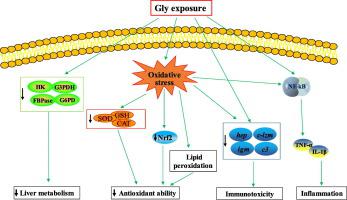Comparative Biochemistry and Physiology C: Toxicology & Pharmacology ( IF 3.9 ) Pub Date : 2020-08-28 , DOI: 10.1016/j.cbpc.2020.108878 Tao Zheng 1 , Rui Jia 2 , Liping Cao 2 , Jinliang Du 2 , Zhengyan Gu 1 , Qin He 1 , Pao Xu 3 , Guojun Yin 3

|
Glyphosate (Gly) is an active ingredient of herbicide, its underlying toxicity on fish is still unclear. The aim of this study was to evaluate chronic toxicity of Gly on tilapia via determining antioxidative status, metabolism, inflammation and immune response. The fish were exposed to different concentrations of Gly (0, 0.2, 0.8, 4 and 16 mg/L) for 80 days. The blood, liver, gills and spleen were collected to assay biochemical parameters and genes expression after 80 days of exposure. The results showed that treatments with higher Gly (4 and/16 mg/L) significantly increased the levels of TC, TG, AST, ALT, LDL-C and MDA, and apparently decreased the levels of SOD, GSH, CAT, HDL-C, HK, G3PDH, FBPase and G6PD in serum, liver and/or gills. The gene expression data showed that the treatments with Gly adversely affected Nrf2 pathway in liver, gills and spleen, as shown by significant changes of nrf2, keap1, ho-1, nqo1 and gsta mRNA levels. Meanwhile, inflammatory response was activated via enhancing the mRNA levels of nf-κb2, rel, rela tnf-α, and il-1β, and immunotoxicity was caused through downregulating the genes expression of c-lzm, hep, igm, hsp70 and c3 in liver, gills and/or spleen of tilapia after Gly exposure. Moreover, the mRNA levels of cyp1a and cyp3a were upregulated in 16 or 0.2 mg/kg Gly group in liver. Overall results suggested chronic Gly exposure reduced antioxidative ability, disturbed liver metabolism, promoted inflammation and suppressed immunity. Interestingly, the Nrf2 and NF-κB signaling pathways played key roles in Gly chronic toxicity.
中文翻译:

长期接触草甘膦对罗非鱼(GIFT、Oreochromis niloticus)抗氧化状态、代谢和免疫反应的影响。
草甘膦(Gly)是除草剂的活性成分,其对鱼类的潜在毒性仍不清楚。本研究的目的是通过测定抗氧化状态、代谢、炎症和免疫反应来评估甘氨酸对罗非鱼的慢性毒性。将鱼暴露于不同浓度的甘氨酸(0、0.2、0.8、4和16 mg/L)80天。暴露80天后,收集血液、肝脏、鳃和脾来测定生化参数和基因表达。结果表明,高Gly(4和/16 mg/L)处理显着提高了TC、TG、AST、ALT、LDL-C和MDA水平,并明显降低了SOD、GSH、CAT、HDL-水平。血清、肝脏和/或鳃中的 C、HK、G3PDH、FBPase 和 G6PD。基因表达数据显示,Gly 处理对肝脏、鳃和脾脏中的 Nrf2 通路产生不利影响,如nrf2 、 keap1 、 ho-1 、 nqo1和gsta mRNA 水平的显着变化所示。同时,通过增强nf-κb2 、 rel 、 rela tnf-α 、 il-1β mRNA水平激活炎症反应,通过下调c-lzm 、 hep 、 igm 、 hsp70 、 c3基因表达引起免疫毒性。甘氨酸暴露后罗非鱼的肝脏、鳃和/或脾脏。此外,肝脏中cyp1a和cyp3a的mRNA水平在16或0.2 mg/kg Gly组中上调。总体结果表明,长期暴露于甘氨酸会降低抗氧化能力,扰乱肝脏代谢,促进炎症并抑制免疫力。 有趣的是,Nrf2 和 NF-κB 信号通路在 Gly 慢性毒性中发挥着关键作用。











































 京公网安备 11010802027423号
京公网安备 11010802027423号